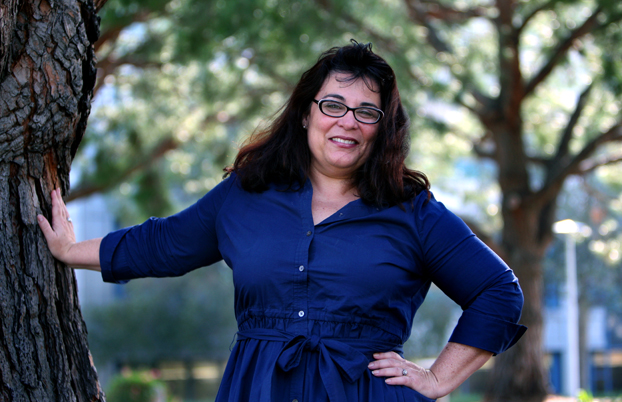 Caption: Michele M. Wood is evaluating the “Great ShakeOut” earthquake drill. Photo by Karen TapiaDownload Photo
Caption: Michele M. Wood is evaluating the “Great ShakeOut” earthquake drill. Photo by Karen TapiaDownload Photo
Studying Seismic Safety
Researcher Evaluates The ‘Great ShakeOut’
AT 10:20 A.M. ON OCT. 20, nearly 10 million people throughout the state, including Cal State Fullerton students, staff and faculty, dropped and ducked under desks, fled down stairwells and exited buildings as part of the fourth annual “Great California ShakeOut” earthquake drill. The drill’s effectiveness over the years now is being evaluated by Michele M. Wood, assistant professor of health science. She has been awarded a $49,900 grant from the State of California's Alfred E. Alquist Seismic Safety Commission to do just that.
As part of the research project, Wood is compiling a report on “Practical Lessons Learned from the Great California ShakeOut.” She answers the following questions about her work:
Q: What is the purpose of this study?
This project was funded to facilitate a systematic examination of ShakeOut evaluation data. The recommendations that will be developed will be based on an integration of the most recent research, as well as evaluation findings, spanning all of the ShakeOut drills to date, since 2008. These recommendations are intended to provide direction about what next steps the state should take in encouraging preparedness for future earthquakes.
The primary goal of earthquake drills like the ShakeOut is to teach people how to take self-protective actions to reduce deaths resulting from a major earthquake. Secondary purposes include reducing injuries, maintaining quality of life and decreasing property loss. Being struck by falling objects is a major source of injury during earthquakes. Learning to “drop, cover and hold on” and practicing these skills can help save lives and reduce injuries during a real earthquake, when people don't have much time to think about what they should do.
During a disaster, such as a major earthquake, hospitals and emergency rooms quickly can become overcrowded. Reducing the number of people who become injured can help ensure that emergency medical care providers have enough time to treat those with the most severe injuries.
Q: What makes people prepare for earthquakes?
Many people believe that we need to scare people in order to get them to take action; this is simply not true. The best research evidence we have to date indicates that receiving information that specifically tells people what to do to prepare, seeing other people in one's social world who have already taken action to prepare, and seeking out additional information about how to prepare are all key factors in motivating people to prepare.
Q: Why should people prepare?
People should prepare for possible future events like major earthquakes because doing so can reduce death and injury and dramatically improve quality of life following a major disaster. Research has shown that one's family, friends and neighbors are typically first on the scene to lend assistance, before official rescue personnel arrive. The greater the number of people who learn how to protect themselves during an earthquake and who take actions to prepare, the greater the number of people who will be available to help others, the fewer who will be in need of help, the more quickly the community can recover and the more resilient it will be.
Q: Do you have any tips most people wouldn't think about when preparing for an earthquake?
The “Putting Down Roots in Earthquake Country Handbook,” which includes the “7 Steps to Earthquake Safety,” and is produced and updated annually by the Southern California Earthquake Center and the Earthquake Country Alliance, is the most comprehensive earthquake preparedness guide I know of. The tips — Identify potential hazards in your home and begin to fix them; Create a disaster-plan; Prepare disaster supplies kits; Identify your building’s potential weaknesses and begin to fix them; Protect yourself during earthquake shaking, drop, cover, and hold on; After the earthquake, check for injuries and damage; When safe, continue to follow your disaster-preparedness plan — can be found online at http://www.earthquakecountry.info/roots/index.php.
Q: What are some of your preliminary findings?
- More than 8.5 million people were registered to participate in this year's ShakeOut, the largest drill in history.
- School participation has grown from 3.5 million in 2008, to 5.5 million in 2011, and from 200 to more than 350 school districts.
- In 2010, 94 percent of school districts and school groups said that their prior ShakeOut participation led to improvements.
- Also, 94 percent of schools reported that students adopted the "drop, cover, hold on" position during the drill; 60 percent reported that all or most teachers discussed the drill with students, and 20 percent reported that follow-up educational materials were sent home.
- A total of 995 individuals who registered on the ShakeOut website as an individual or household responded to the 2010 survey.
- In the months leading up to the 2010 ShakeOut drill, 69 percent of respondents encouraged others to participate, and 54 percent reviewed the ShakeOut drill manuals.
- In the year leading up to the 2010 ShakeOut drill, 81 percent of respondents had encouraged others to learn about earthquake safety or preparedness; 79 percent had encouraged others to participate in the ShakeOut drill, and 66 percent had encouraged others to visit the ShakeOut website.
Q: What do you think about the Great ShakeOut?
Drills like the ShakeOut are immensely useful because they not only increase awareness and knowledge about what to do before, during and after an earthquake, but they also help build the skills needed to protect personal safety during a major event. The enormous scope and successful "bandwagon effect" has enabled the ShakeOut drill to become a powerful force in shifting social norms and expectations about preparedness.
Nov. 22, 2011
